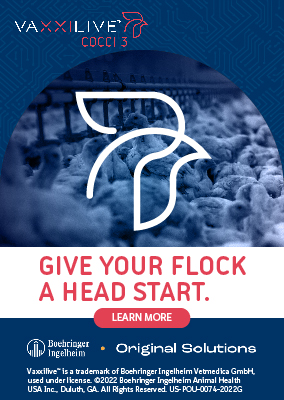First in a two-part series
 Immunosuppression is a term that poultry veterinarians use to describe the effects of diseases that compromise the immune system and sometimes lead to secondary infections.
Immunosuppression is a term that poultry veterinarians use to describe the effects of diseases that compromise the immune system and sometimes lead to secondary infections.
But what exactly is immunosuppression? How does it manifest in chickens clinically and subclinically? And how can it be diagnosed and measured?
In a recent interview, Bill Stanley, DVM, a poultry veterinarian with Boehringer Ingelheim who’s worked extensively in the field with immunosuppressive diseases — Marek’s disease (MD) and infectious bursal disease (IBD), to name a few — shared his expertise on the topic and, more significantly, explained what veterinarians and other decision-makers need to know about this costly yet often misunderstood problem.
Isabel Gimeno, DVM, PhD, a professor and immunologist at North Carolina State University (NCSU) who has conducted research and published dozens of scientific articles on tumor-causing poultry diseases, provided additional perspectives.
Q: First, let’s get everyone on the same page with a simple definition of immunosuppression.
Stanley: Simply put, immunosuppression is a decrease in the activity or efficacy of the immune system.
Immunosuppression manifests in chickens in many ways, often leading to secondary bacterial infections. These infections include colibacillosis, systemic infections of Enterococcus spp., and clostridial diseases such as necrotic enteritis and gangrenous dermatitis.
The condition also can lead to poor response to vaccination, increases in Salmonella colonization in the intestines and higher incidence of viral infections such as inclusion body hepatitis, infectious laryngotracheitis (ILT), infectious bronchitis virus (IBV) and avian metapneumovirus (aMPV).
Gimeno: I like to think of immunosuppression as an iceberg; we see just a fraction of the problem on the surface, but it’s actually much bigger and deeper.
As Dr. Stanley indicated, affected flocks may see poor responses to vaccines or increased incidence of disease in immunosuppressed flocks. However, before we even think that immunosuppression is the primary cause for a poultry company’s economic losses, it’s important to understand the producer has already lost a lot of money from the ripple effect of the condition. For example:
- Flock performance might have been substandard well before the producer realized there was immunosuppression in the flock;
- Treatments to control parasitic and/or bacterial diseases might have been less effective than expected;
- Routine vaccination programs against common diseases might have been less effective and needed to be modified or intensified to improve protection.
Q: Dr. Stanley, you cited a long list of health problems stemming from immunosuppression.
Stanley: It is a long list. And unfortunately, it doesn’t end there.
In immunosuppressed flocks, we also see more aggressive cycling of Eimeria, which causes coccidiosis — a condition that almost always leads to reductions in live performance. In these situations, it’s also common to observe clinical changes in immune organs, such as the bursa of Fabricius and thymus.
Gimeno: Actually, the list of health problems from immunosuppression is even longer than that.
Understand that a proper immune response is critical to protect the chickens against any pathogen — not just those that cause immunosuppressive diseases.
Furthermore, in the poultry industry, we primarily rely on preventive medicine because our options for treatments are very limited. If flocks are immunosuppressed, they will be unable to mount an immune response to an infection or to a vaccine.
Assessing immunosuppression
Q: What clinical changes do you see in immunosuppressed flocks?
Stanley: We might see an increase or decrease in immune-organ size, hemorrhaging within the tissue and/or changes in color. Gross changes in the organs are often subtle and require the help of a trained avian pathologist to determine the presence or absence of disease.
Gimeno: Unfortunately, immunosuppression isn’t always obvious. Sometimes you do not see one disease that’s causing immunosuppression. In many immunosuppressed flocks, we see only secondary infections or poor response to vaccination in general. That is typically what happens with the immunosuppression induced by MD virus.
Q: Is there a way immunosuppression in poultry can be measured?
Stanley: Yes, but it’s challenging. Researchers have developed in vivo models to determine immunosuppression levels indirectly.
One of these models uses a combination of known pathogenic viruses (very virulent+ MD and ILT), vaccines (chicken embryo-origin or CEO, ILT and MD vaccines) and clinical observations to see whether CEO vaccination in the face of MD virus challenge still protects chicks from ILT challenge.
To see the presence of immunosuppression in the field, it’s also important to understand the three key factors that form the immune-health triad of the bird. The three factors are:
- The chicken’s genetics and development of the bursa and thymus;
- The chicken’s environment — housing conditions, feed, lighting, ventilation, water, resident microorganisms and so on;
- Pathogens that attack the primary immune organs.
Any mismanagement of the three elements in the triad could lead to an immune-system deficiency.
Often in the field, the best indicator of immunosuppression in chickens is higher incidence of the previously noted secondary diseases.
Gimeno: As Dr. Stanley has mentioned, immunosuppression can be measured, but it’s not always easy to do. It greatly depends on the cause of immunosuppression.
Some viruses — IBD virus, for example — affect mainly the humoral immune responses (antibodies). One can assess immunosuppression due to IBDV based on atrophy of the bursa of Fabricius and lack of proper antibody responses to various vaccines.
Measuring antibodies by ELISA (enzyme-linked immunosorbent assay) is another option. Antibody testing by ELISA is done routinely in commercial flocks. However, other viruses such as chicken anemia virus (CAV) affect mainly the cellular immune responses (cytotoxic T lymphocytes or CTL), which are more complex to evaluate.
Thymus atrophy could be a lesion to evaluate, but measuring reduced CTL responses in the laboratory requires sophisticated assays that cannot be done routinely.
Things get even more complicated with MD virus or mycotoxins. They affect every single aspect of the immune response (innate, humoral and cellular) but might not be associated with lymphoid organ atrophy. In those cases, further studies need to be done to better understand the mechanisms, so we can develop diagnostic tools.
Managing MD virus
Q: Let’s take a moment to focus specifically on the MD virus. How does a natural MD virus challenge or use of a MD virus vaccine affect poultry immune systems? What’s the significance of these changes?
Stanley: T cells originate from the thymus and have many functions in a healthy immune response. As these cells mature, they play a key role in cell-mediated immunity.Dr. Gimeno and her research team at NCSU have studied T-cell maturation. They’ve learned the faster T cells mature, the better prepared the bird will be to deal with microbiological challenges in the production system.
Gimeno: MD virus is a master in regulating the immune responses. It affects the innate immune responses (initial form of defense that is not specific and has no memory), the humoral immune responses (antibodies) and CTL.
MD virus also has numerous mechanisms, many of them still poorly elucidated. For example:
- MD virus replicates and kills B cells and activated T cells (both CD4 and CD8);
- MD virus reduces the ability of lymphocytes to proliferate when in contact with an antigen;
- MD virus downregulates MHC-I (major histocompatibility complex class I) so the CTL responses are affected and causes neoplastic transformation of CD4 T cells.
The impact of such changes in commercial flocks depends on the virulence of the virus. When the challenge is virulent MD virus (vMDV) or very virulent MD virus (vvMDV), most if not all these changes can be controlled by maternal antibodies (vMDV) or vaccination (vvMDV).
When the challenge is a very virulent plus MD virus (vv+MDV), neither maternal antibodies nor conventional vaccines can fully protect against the damage to the immune responses.
We have demonstrated that even vaccination programs using CVI988 (Rispens) — alone or in combination with herpesvirus of turkey (HVT) vaccines that protect efficiently against tumors — fail to guard against MD virus immunosuppression induced by vv+MDV strains.
We have identified two types of vaccines that protect against vv+MD virus-induced immunosuppression: an experimental vaccine with deletion of the oncogene meq and the chimeric vaccine, PREVEXXION®RN.
Q: So, how do different MD viruses affect vaccination strategies?
Stanley: Dr. Gimeno’s research showed that vaccines built on HVT — which include most recombinant vaccines used for MD virus, IBD, ILT and/or Newcastle disease — hasten the maturation of T lymphocytes.
In our research, we’ve found that when the MD chimera vaccine Prevexxion is administered in ovo to 18- to 19-day-old embryonated chicken eggs to protect against the very virulent+ MD virus, the response is even better and earlier than other vaccines or vaccine combinations. This is important because it allows faster immune development and faster responses to field challenges.
Dr. Gimeno’s team is also studying other cell types, including CD4, CD8 (alpha and beta) T cells, as well as macrophages. They’ve shown quantitative changes of these cell types in response to challenge and vaccination.
Q: Dr. Gimeno, would you please provide more take-away messages about that work?
Gimeno: We have demonstrated that in commercial chickens, the immunosuppression induced by MD virus starts at 4 to 5 weeks of age. Also, we have reported that the impact of the MD virus-induced immunosuppression depends on the virulence of the challenge.
The vaccination program needed to control MD virus-induced immunosuppression will depend on the specific situation of the flock.
On farms exposed to vMDV or vvMDV, the same vaccination that protects against tumors will protect against immunosuppression. However, if the challenge is vv+MDV, conventional vaccination might not be enough to protect against immunosuppression, even if it is protecting against tumors.
Q: Dr. Stanley, as a veterinarian who works with top poultry companies, what is the significance of Dr. Gimeno’s work in the field?
Stanley: It’s quite significant. Demonstrating quantitative changes of the aforementioned cell types (post-vaccination challenge) helps us understand the mechanisms of action for the vaccines and differences between vaccines. It also helps our understanding of differences between vaccine and field viruses.
We’ve also learned more about the maturation timeline of the avian immune system. It is best to have a fast maturation process so the bird can respond to field challenge as soon as possible.
To support this point, another research student on Dr. Gimeno’s team recently published that in ovo HVT hastens immunocompetence and T-cell activation, which better prepares chicks for early pathogen exposure, including MD virus (Boone et al. Vaccine 2023).
Gimeno: I have studied many aspects of MD virus for 3 decades. To me, there have been four areas of particular relevance for the poultry industry:
- Novel methods for diagnosis of tumors, even as early as 3 weeks of age, based on quantitative polymerase chain reaction (PCR;
- A better understanding of which new features MD virus acquires as it becomes more virulent and what to expect in the field;
- Development of novel vaccines or vaccination protocols that can enhance the control of vv+MD virus; and more recently,
- Development of a method to reproduce MD virus immunosuppression under laboratory conditions, which has been critical to identify the extension of the damage that vv+MDV can cause to the immune responses. This is one of the current projects we have in my laboratory today.
Our next goal is to use this gained knowledge to develop methods of diagnosis that can be used in commercial flocks.
Another goal of research in my laboratory, as Dr. Stanley indicated, is to find methods to accelerate the immunocompetence of chickens before they hatch.
We have demonstrated that in ovo vaccination with HVT acts like an adjuvant of the immune response and results in baby chicks that can respond better to pathogens when they hatch. At this point, we are evaluating how we can enhance even further the adjuvant effect of HVT.
Monitoring thymus health
Q: Is the health of the thymus an indicator of a flock’s immune status?
Stanley: Yes, but measuring thymus health directly is challenging. The most useful method today is to look at the thymus histologically in a systematic way. This involves routine collection of multiple birds at different ages from a production complex.
Thymus lesions and severity over the number of birds affected in each age group will offer an understanding of thymus health for the flock.
Gimeno: The thymus is a critical organ for the immune response because it is the place where T cells are developed. Unfortunately, evaluating the thymus is more challenging than evaluating the spleen; hence, the thymus has been long forgotten.
As Dr. Stanley suggested, I would strongly recommend including routine evaluation of the thymus when assessing the health of a flock.
From the research perspective, certainly for MD virus studies, we need to focus our efforts on the thymus. We recently reported that MD virus-1 vaccines are detected in the thymus before they are detected in the spleen or bursa.
We also recently found that the replication and changes in the frequency of immune cells in the thymus is different for those vaccines that protect against MD virus immunosuppression caused by vv+MDV versus those that do not. A better understanding of the pathogenesis of vv+MDV in the thymus and the effects of various vaccines in controlling the early stages of infection in the thymus is needed.
MD virus immunosuppression
Q: Literature on MD virus immunosuppression often mentions MD virus/cell interaction. What exactly is that? What do poultry producers need to understand?
Stanley: Depending on the type and quantity of field-challenge virus, as well as other triad factors, birds may be completely unprotected against latent immunosuppression caused by MD virus.
In fact, it’s estimated that 30% of MD field viruses can cause immunosuppression, even with the use of common commercial vaccines.
Fortunately, the unique chimera technology in Prevexxion® is capable of fully protecting against all types of MD virus challenge.
Gimeno: In the context of MD virus infection, virus-host interaction means the type of infection that MD virus is establishing on a particular cell.
There are some cells — B cells, for instance — in which MD virus fully replicates but does not form infectious particles. There are other cells in which the virus can establish latency, which means the virus is inserted into the genome of the cells, but it does not replicate (CD4+ T cells).
The same cells that support latency can suffer neoplastic transformation and become lymphomas. The virus can also reactivate in them and replicate at least partially.
Finally, there is just one type of cell (feather follicle epithelium) where the virus can fully replicate and form infectious particles necessary to infect other chickens.
Poultry producers need to understand that the pathogenesis of MD virus is complex. Most are familiar with MD virus-inducing tumors, and fortunately, we do have proper tools to protect against them. However, because MD virus can establish different types of interaction with the cells, it can induce many other things in the chickens.
Today, MD virus immunosuppression is the most dangerous consequence of virus infection because it can happen in chickens that do not have lymphoid organ atrophy nor tumors and because conventional vaccines do not protect against them.
The good news is that only vv+MDV can cause it and not every farm has vv+MDV. The bad news is that it is difficult to assess the virulence of the virus, so most farms do not know how virulent their challenge is.
Q: When observing a flock, what signs might suggest it is suffering from MD-related immunosuppression?
Stanley: Due to the complexity of factors involved in a field case, it may be difficult to distinguish the agent responsible for the infection. However, the observation of secondary infections from bacteria and/or viruses may be indicators of MD virus-related immunosuppression.
Because MD virus targets both the thymus and the bursa, an observation of cell-mediated and humoral immunosuppression, coupled with the potential presence of tumors, are clues that MD virus may be involved.
Gimeno: I always tell my students that if there is a flock that is constantly performing poorly and suffering from several unrelated diseases, it is most likely immunosuppressed.
The problem is determining how to pinpoint what is the cause of immunosuppression and if there is one single cause. Because MD virus is ubiquitous — most commercial chickens get infected with MD virus at some point — and MD virus immunosuppression is not necessarily related to lymphoid organ atrophy nor tumors, we do not have a direct diagnosis method.
It is imperative that more studies are done to develop diagnostic methods for MD virus immunosuppression. However, MD virus is currently not considered a priority for the US poultry industry, nor for funding agencies.
In the meantime, one can rule out other immunosuppressive agents that are easier to diagnose (i.e., IBD virus and CAV). However, it is important to keep in mind that it is not uncommon for multiple immunosuppressive agents to be present in a flock. Poor protection against one virus can have a domino effect. For example:
- Poor protection against IBD virus will affect immunity against CAV.
- Poor protection against CAV will affect protection against MD virus.
- Even worse, poor protection against MD virus will affect protection of both IBD virus and CAV.
In the second part of this interview, Drs. Stanley and Gimeno discussed ways to optimize vaccine performance. Click here for more.
PREVEXXION® is a registered trademark of Boehringer Ingelheim Animal Health USA Inc. US-POU-0048-2024
For more information on managing immunosuppression in poultry, contact william.stanley@boehringer-ingelheim.com or imgimeno@ncsu.edu.
Editor’s note: Content on Modern Poultry’s Industry Insights pages is provided and/or commissioned by our sponsors, who assume full responsibility for its accuracy and compliance.









